Characterizing Extratropical Tropopause Bimodality and its Relationship to the Occurrence of Double Tropopauses Using COSMIC GPS Radio Occultation Observations
Abstract
:1. Introduction
2. Data and Methods
3. Results
3.1. Bimodal Tropopause Locations and Characteristics
3.2. Relationship of Double Tropopauses to the Occurrence of LRT Bimodality
4. Discussion
5. Conclusions
Author Contributions
Funding
Acknowledgments
Conflicts of Interest
References
- Añel, J.A.; Antuña, J.C.; De La Torre, L.; Castanheira, J.M.; Nieto, R. Climatological features of global multiple tropopause events. J. Geophys. Res. Space Phys. 2008, 113, 1–14. [Google Scholar] [CrossRef] [Green Version]
- Holton, J.R.; Haynes, P.; Rood, R.; Pfister, L.; McIntyre, M.E.; Douglass, A.R. Stratosphere-troposphere exchange. Rev. Geophys. 1995, 33, 403. [Google Scholar] [CrossRef]
- Randel, W.J.; Seidel, D.J.; Pan, L.L. Observational characteristics of double tropopauses. J. Geophys. Res. Space Phys. 2007, 112, 1–13. [Google Scholar] [CrossRef] [Green Version]
- World Meteorological Organization (WMO). Atmospheric Ozone 1985; WMO: Geneva, Switzerland, 1986; Volume 16. [Google Scholar]
- Hoskins, B.J.; McIntyre, M.E.; Robertson, A.W. On the use and significance of isentropic potential vorticity maps. Q. J. R. Meteorol. Soc. 2007, 111, 877–946. [Google Scholar] [CrossRef]
- Pan, L.L.; Randel, W.J.; Gary, B.L.; Mahoney, M.J.; Hintsa, E.J. Definitions and sharpness of the extratropical tropopause: A trace gas perspective. J. Geophys. Res. Space Phys. 2004, 109, 1–11. [Google Scholar] [CrossRef]
- Fueglistaler, S.; Dessler, A.; Dunkerton, T.J.; Folkins, I.; Fu, Q.; Mote, P.W. Tropical tropopause layer. Rev. Geophys. 2009, 47, 1–31. [Google Scholar] [CrossRef]
- Pan, L.L.; Randel, W.J.; Gille, J.C.; Hall, W.D.; Nardi, B.; Massie, S.; Yudin, V.; Khosravi, R.; Konopka, P.; Tarasick, D.W. Tropospheric intrusions associated with the secondary tropopause. J. Geophys. Res. Space Phys. 2009, 114, 1–12. [Google Scholar] [CrossRef] [Green Version]
- Birner, T. Fine-scale structure of the extratropical tropopause region. J. Geophys. Res. Space Phys. 2006, 111, 111. [Google Scholar] [CrossRef] [Green Version]
- Homeyer, C.R.; Bowman, K.P.; Pan, L.L. Extratropical tropopause transition layer characteristics from high-resolution sounding data. J. Geophys. Res. Space Phys. 2010, 115, 1–12. [Google Scholar] [CrossRef] [Green Version]
- Gettelman, A.; Hoor, P.; Pan, L.L.; Randel, W.J.; Hegglin, M.I.; Birner, T. The Extratropical Upper Troposphere and Lower Stratosphere. Rev. Geophys. 2011, 49, 1–31. [Google Scholar] [CrossRef] [Green Version]
- Peevey, T.; Gille, J.C.; Homeyer, C.R.; Manney, G.L. The double tropopause and its dynamical relationship to the tropopause inversion layer in storm track regions. J. Geophys. Res. Atmos. 2014, 119, 10. [Google Scholar] [CrossRef] [Green Version]
- Santer, B.D.; Boyle, J.S.; AchutaRao, K.; Doutriaux, C.; Roeckner, E.; Ruedy, R.; Schmidt, G.A.; Sausen, R.; Wigley, T.M.L.; Hansen, J.E.; et al. Behavior of tropopause height and atmospheric temperature in models, reanalyses, and observations: Decadal changes. J. Geophys. Res. Space Phys. 2003, 108, 1–22. [Google Scholar] [CrossRef] [Green Version]
- Feng, S.; Fu, Y.; Xiao, Q. Is the tropopause higher over the Tibetan Plateau? Observational evidence from Constellation Observing System for Meteorology, Ionosphere, and Climate (COSMIC) data. J. Geophys. Res. Space Phys. 2011, 116, 1–12. [Google Scholar] [CrossRef] [Green Version]
- Seidel, D.J.; Randel, W.J. Recent widening of the tropical belt: Evidence from tropopause observations. J. Geophys. Res. Space Phys. 2007, 112, 20113. [Google Scholar] [CrossRef] [Green Version]
- Seidel, D.J.; Randel, W.J. Variability and trends in the global tropopause estimated from radiosonde data. J. Geophys. Res. Space Phys. 2006, 111, 1–17. [Google Scholar] [CrossRef]
- Castanheira, J.M.; Gimeno, L. Association of double tropopause events with baroclinic waves. J. Geophys. Res. Space Phys. 2011, 116, 1–9. [Google Scholar] [CrossRef] [Green Version]
- Peevey, T.; Gille, J.C.; Randall, C.E.; Kunz, A. Investigation of double tropopause spatial and temporal global variability utilizing High Resolution Dynamics Limb Sounder temperature observations. J. Geophys. Res. Space Phys. 2012, 117, 1–14. [Google Scholar] [CrossRef] [Green Version]
- Schmidt, T.; Beyerle, G.; Heise, S.; Wickert, J.; Rothacher, M. A climatology of multiple tropopauses derived from GPS radio occultations with CHAMP and SAC-C. Geophys. Res. Lett. 2006, 33, 1–4. [Google Scholar] [CrossRef]
- Shapiro, M.A. Turbulent Mixing within Tropopause Folds as a Mechanism for the Exchange of Chemical Constituents between the Stratosphere and Troposphere. J. Atmos. Sci. 1980, 37, 994–1004. [Google Scholar] [CrossRef]
- Anthes, R.A.; Bernhardt, P.A.; Chen, Y.; Cucurull, L.; Dymond, K.; Ector, D.; Healy, S.B.; Ho, S.-P.; Hunt, D.C.; Kuo, Y.-H.; et al. The COSMIC/FORMOSAT-3 Mission: Early Results. Bull. Am. Meteorol. Soc. 2008, 89, 313–334. [Google Scholar] [CrossRef]
- Rieckh, T.; Scherllin-Pirscher, B.; Ladstädter, F.; Foelsche, U. Characteristics of tropopause parameters as observed with GPS radio occultation. Atmos. Meas. Tech. 2014, 7, 3947–3958. [Google Scholar] [CrossRef] [Green Version]
- Son, S.-W.; Tandon, N.F.; Polvani, L.M. The fine-scale structure of the global tropopause derived from COSMIC GPS radio occultation measurements. J. Geophys. Res. Space Phys. 2011, 116, 1–17. [Google Scholar] [CrossRef]
- Zhang, X.; Gao, P.; Xu, X. Variations of the Tropopause Over Different Latitude Bands Observed Using COSMIC Radio Occultation Bending Angles. IEEE Trans. Geosci. Remote. Sens. 2014, 52, 2339–2349. [Google Scholar] [CrossRef]
- Smith, E.; Weintraub, S. The Constants in the Equation for Atmospheric Refractive Index at Radio Frequencies. Proc. IRE 1953, 41, 1035–1037. [Google Scholar] [CrossRef] [Green Version]
- Danzer, J.; Foelsche, U.; Scherllin-Pirscher, B.; Schwarz, M. Influence of changes in humidity on dry temperature in GPS RO climatologies. Atmos. Meas. Tech. 2014, 7, 2883–2896. [Google Scholar] [CrossRef] [Green Version]
- Foelsche, U.; Borsche, M.; Steiner, A.; Gobiet, A.; Pirscher, B.; Kirchengast, G.; Wickert, J.; Schmidt, T. Observing upper troposphere–lower stratosphere climate with radio occultation data from the CHAMP satellite. Clim. Dyn. 2007, 31, 49–65. [Google Scholar] [CrossRef] [Green Version]
- Kursinski, E.R.; Hajj, G.A.; Schofield, J.T.; Linfield, R.P.; Hardy, K.R. Observing Earth’s atmosphere with radio occultation measurements using the Global Positioning System. J. Geophys. Res. Space Phys. 1997, 102, 23429–23465. [Google Scholar] [CrossRef]
- Johnston, B.; Xie, F.; Liu, C. The Effects of Deep Convection on Regional Temperature Structure in the Tropical Upper Troposphere and Lower Stratosphere. J. Geophys. Res. Atmos. 2018, 123, 1585–1603. [Google Scholar] [CrossRef]
- Otsu, N. A Threshold Selection Method from Gray-Level Histograms. IEEE Trans. Syst. Man Cybern. 1979, 9, 62–66. [Google Scholar] [CrossRef] [Green Version]
- Bangare, S.L.; Dubal, A.; Bangare, P.S.; Patil, S.T. Reviewing Otsu’s Method for Image Thresholding. Int. J. Appl. Eng. Res. 2015, 10, 21777–21783. [Google Scholar]
- Senthilkumaran, N.; Vaithegi, S. Image Segmentation by Using Thresholding Techniques for Medical Images. Comput. Sci. Eng. Int. J. 2016, 6, 1–13. [Google Scholar] [CrossRef]
- Lee, S.U.; Chung, S.Y.; Park, R.H. A Comparative Performance Study of Several Global Thresholding Techniques for Segmentation. Comput. Vision Graph. Image Process. 1990, 52, 171–190. [Google Scholar] [CrossRef]
- Randel, W.J.; Wu, F. The Polar Summer Tropopause Inversion Layer. J. Atmos. Sci. 2010, 67, 2572–2581. [Google Scholar] [CrossRef]

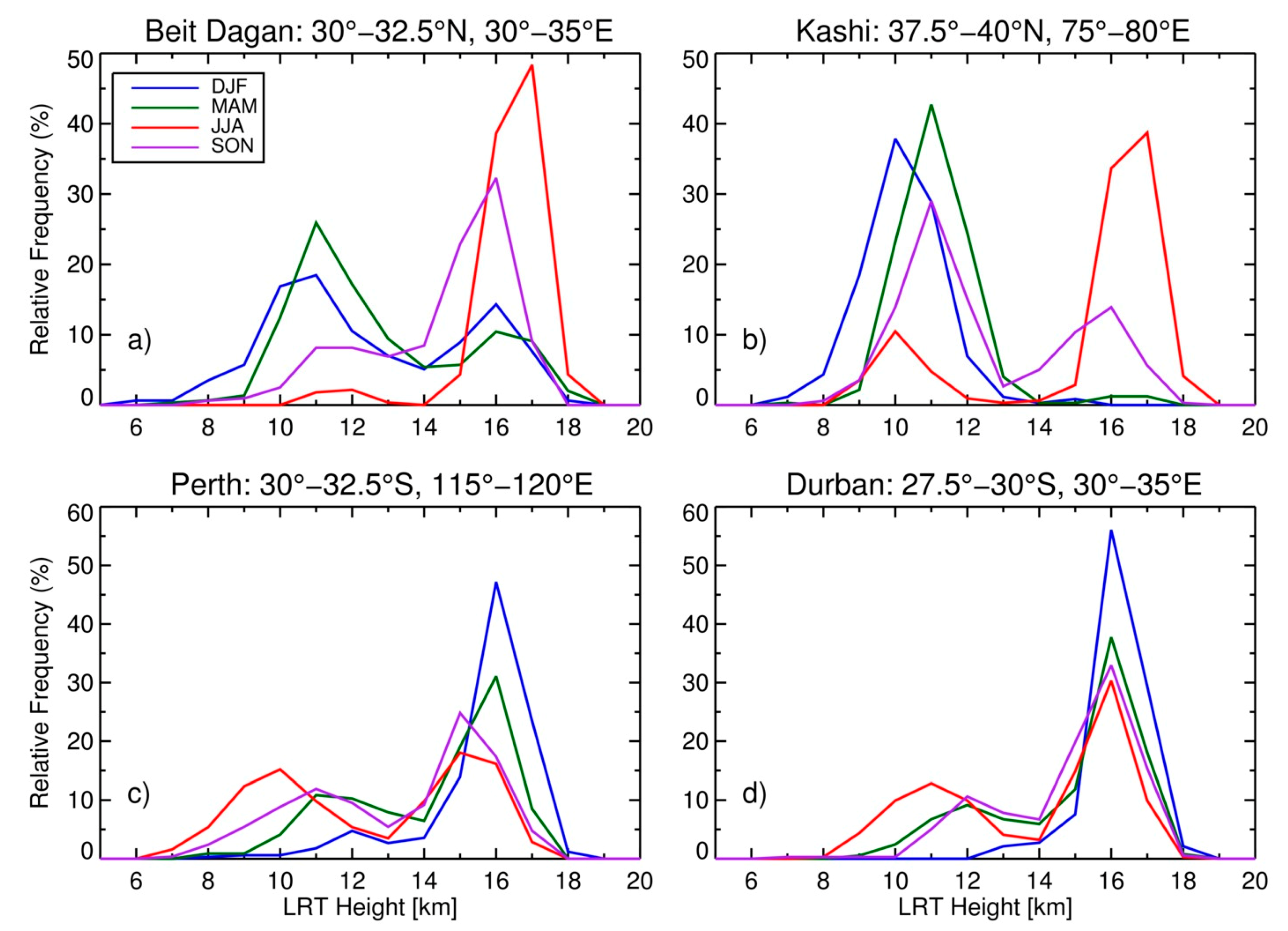
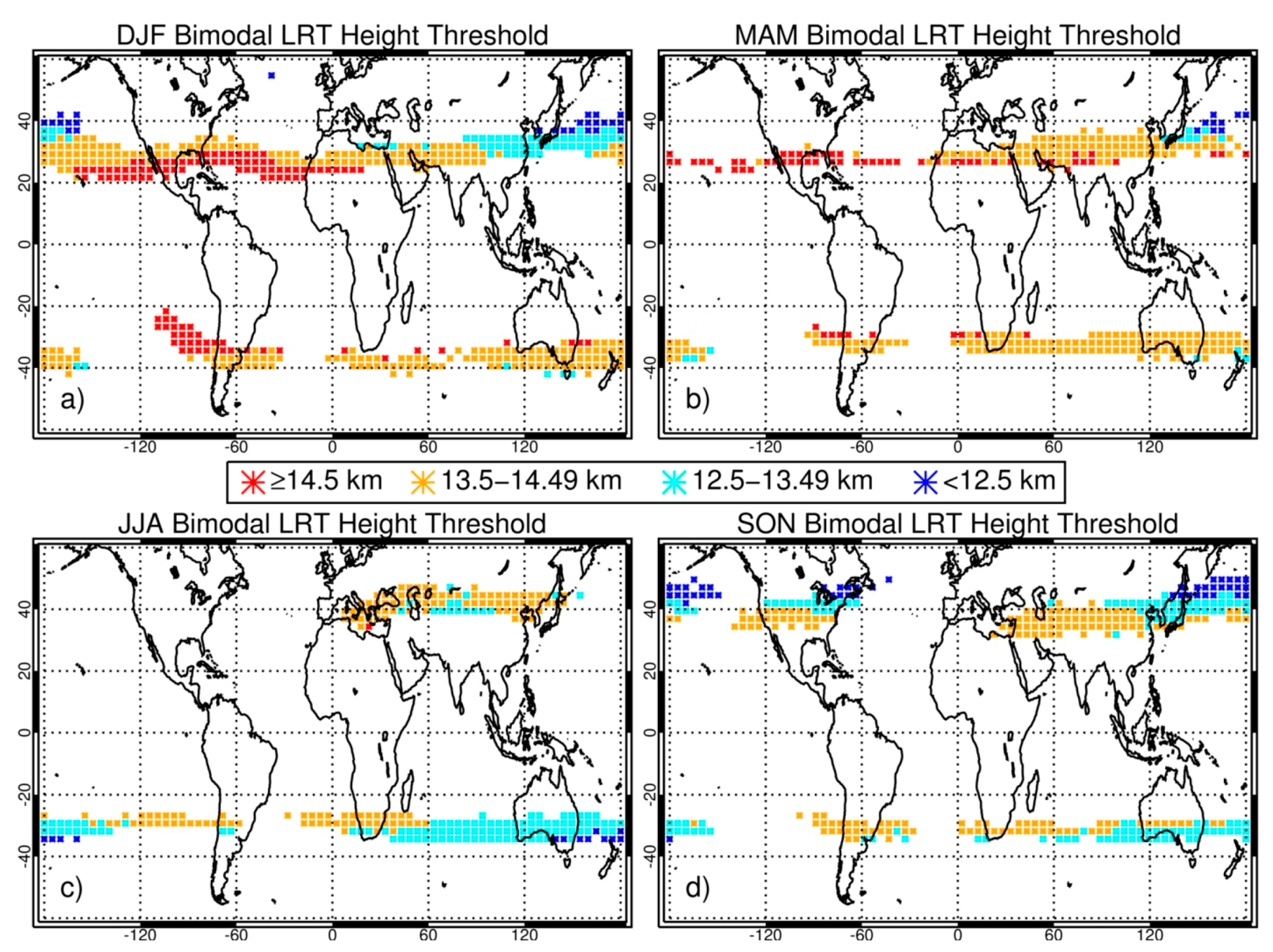
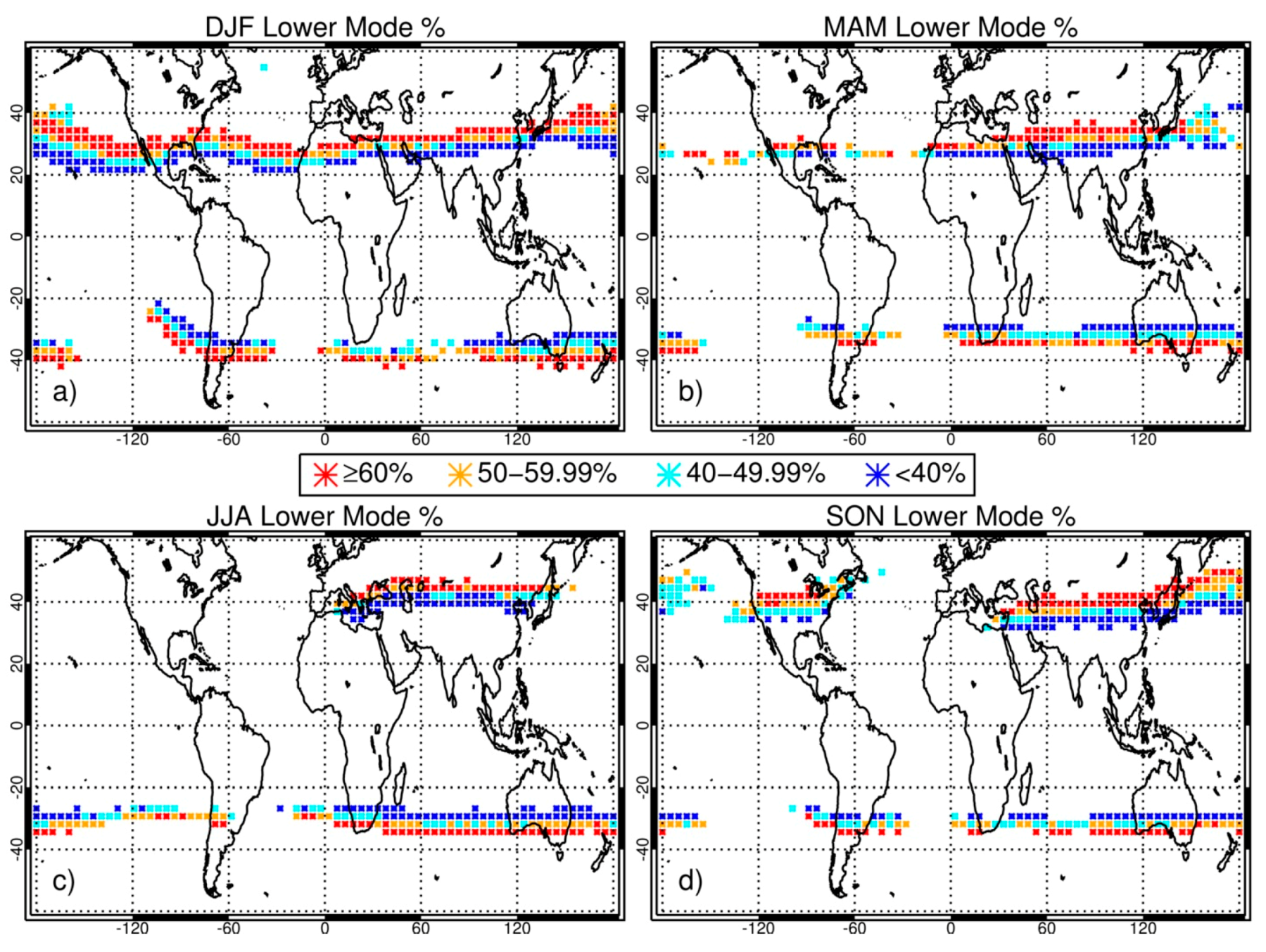


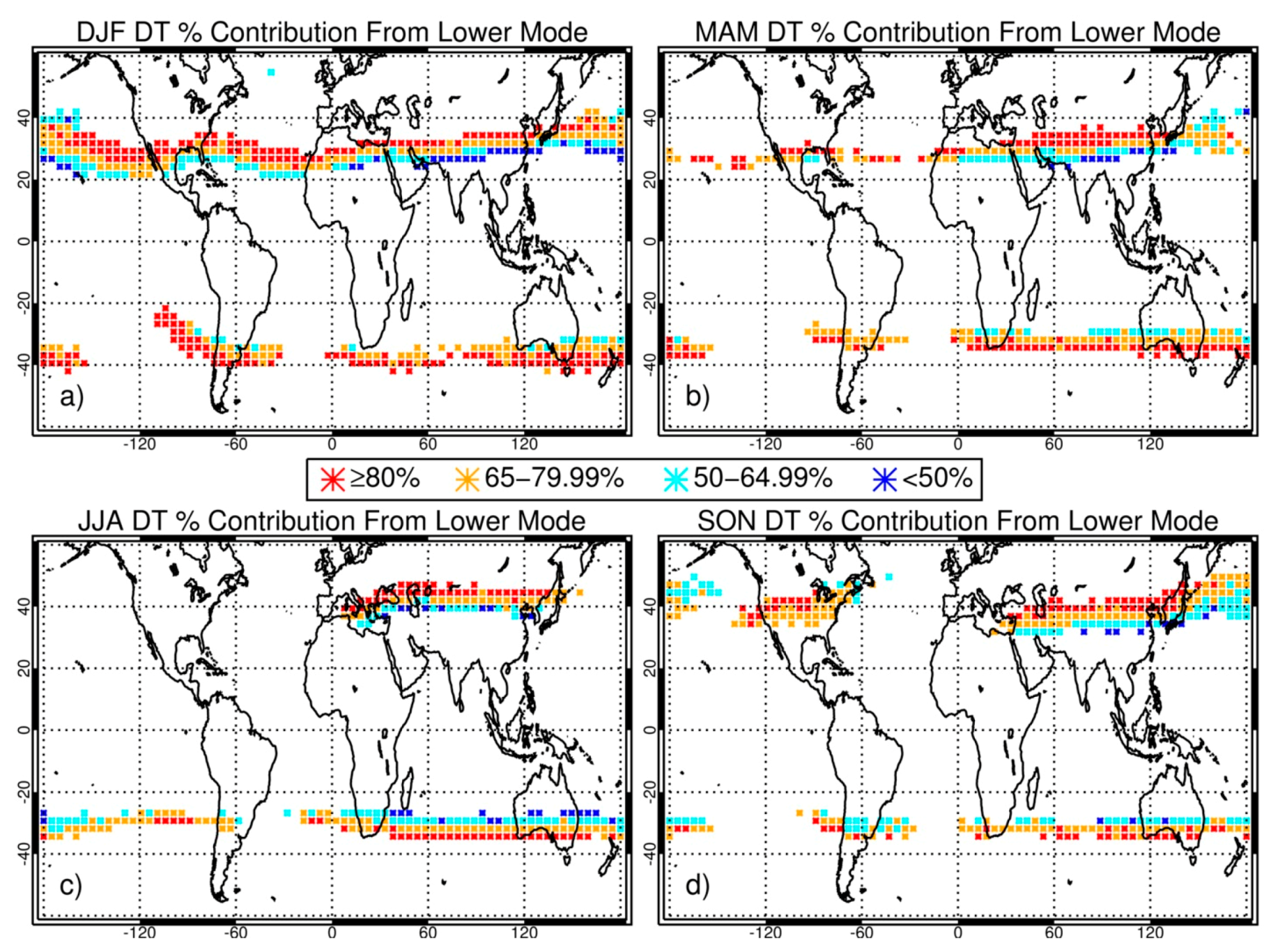

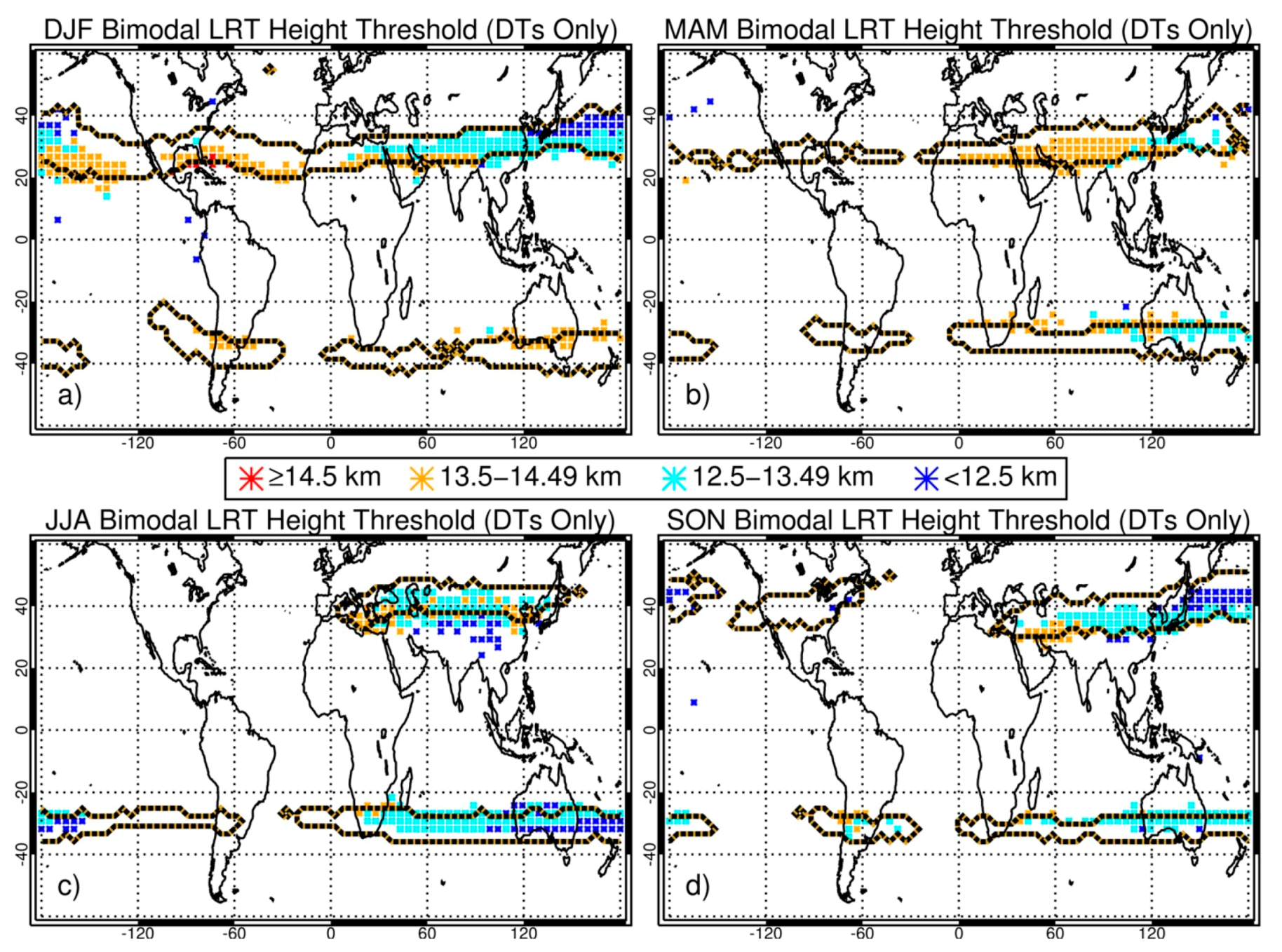

© 2020 by the authors. Licensee MDPI, Basel, Switzerland. This article is an open access article distributed under the terms and conditions of the Creative Commons Attribution (CC BY) license (http://creativecommons.org/licenses/by/4.0/).
Share and Cite
Johnston, B.; Xie, F. Characterizing Extratropical Tropopause Bimodality and its Relationship to the Occurrence of Double Tropopauses Using COSMIC GPS Radio Occultation Observations. Remote Sens. 2020, 12, 1109. https://doi.org/10.3390/rs12071109
Johnston B, Xie F. Characterizing Extratropical Tropopause Bimodality and its Relationship to the Occurrence of Double Tropopauses Using COSMIC GPS Radio Occultation Observations. Remote Sensing. 2020; 12(7):1109. https://doi.org/10.3390/rs12071109
Chicago/Turabian StyleJohnston, Benjamin, and Feiqin Xie. 2020. "Characterizing Extratropical Tropopause Bimodality and its Relationship to the Occurrence of Double Tropopauses Using COSMIC GPS Radio Occultation Observations" Remote Sensing 12, no. 7: 1109. https://doi.org/10.3390/rs12071109
APA StyleJohnston, B., & Xie, F. (2020). Characterizing Extratropical Tropopause Bimodality and its Relationship to the Occurrence of Double Tropopauses Using COSMIC GPS Radio Occultation Observations. Remote Sensing, 12(7), 1109. https://doi.org/10.3390/rs12071109






